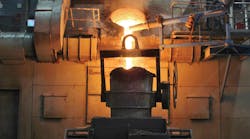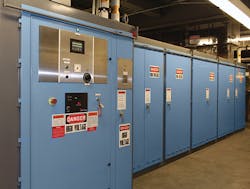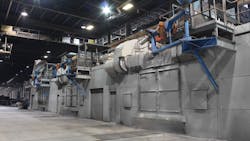Melting sets the pace for every foundry: producing molten metal on schedule, on budget, and in the requisite volumes at required metallurgical qualities is the starting point for successful metalcasting. This is among the primary reasons that so many foundries adopt induction melting: it is a fast and predictable route to molten metal, reliably hitting the targets for throughput and scheduling, and keeping productivity high. But every foundry is different, requiring specific, customized solutions to keep all those variables on target consistently.
The melt-shop replacement program completed last year by Inductotherm for Betz Industries is an example of all these factors. Helping the foundry to maintain its process and product standards while raising its productivity required a customized design and installation, based on the most advanced melting, power-supply, and control technologies.
Betz Industries realized it needed to replace its three induction melters, identical 13.5-mt open-frame furnaces in service at the Grand Rapids, MI, gray and ductile iron foundry for more than 35 years.
Betz Industries specializes at supplying large castings, from 500 to 60,000 lbs., for automotive stamping dies, tool-and-die production, machine tools and industrial tooling, and for alternative energy systems. “Each industry has its own unique requirements, requiring specific metal chemistry or mechanical properties,” according to Betz vice president of Operations David Moorhead, referring to NAAMS (automotive), ASTM (tooling industry), and international quality standards like DIN and ISO.
Moorhead recalled that Betz’ aim in the furnace replacement project was to improve the rate of molten metal production, “to keep up with the rest of the foundry.” The foundry’s molding operation had been modernized a few years prior, raising the necessity of increasing melting productivity to match the potential of the mold production.
“They (the original furnaces) did a great job for almost 40 years,” Moorhead said. “Our volume kept increasing and the size of the castings did as well.
“We also wanted to do the right thing and improve the environmental side of the process,” he noted. “The hooding and dust collection have improved the workplace environment dramatically,” he said of the now revamped melting operation.
There were other practical objectives, too. “We have very large flask sizes,” Moorhead continued, noting the foundry may pour 50,000 lb. of iron as a single pour. “But, another thing is that our operation is 100% lost foam, so every pour has to be perfect because the pattern is vaporized as the metal fills and takes it shape. So, we have one shot at getting it right,” he emphasized.
Even more, because the molds are so large, Betz has to transport the iron in ladles, such that the temperature and the chemistry of the iron being tapped out to the ladles have to be as precise as possible. In short, every aspect of the furnace design and placement had to fit the existing plant and production processes.
Also, operating practices at Betz Industries emphasize “redundancy.” Moorhead explained. “We don’t want to be caught with a furnace down and have no ability to melt metal.” That explains the foundry’s dual cranes on runways, dual mixers, and so forth. “We are not going to let one piece of equipment shut us down.”
One more thing: Betz Industries has been family-owned since 1933, and owner Karl Betz wanted to make sure the third-generation had a state-of-the-art melting facility before he retired. “This meant many years of research and design, talking with furnace manufacturers and other foundries,” Moorhead revealed. “He was not going to sacrifice any part of the system to ensure quality; he wanted a perfect system.”
Inductotherm Corp., noted for expertise in induction melting, heating, holding, and pouring systems was identified and selected to redesign the Betz Industries melting operation, doubling the melting capacity with three new, 20-MT steel frame furnaces, each one with its own 8-MW VIP® Power-Trak® power supply system. In 2011, after much planning and evaluation, the replacement process began.
The installation process stretched over that year. Moorhead explained that the new design required the existing buildings to be enlarged to accommodate the larger furnaces. “We wanted the vault (where the power supplies sit) and the deck to have ample room,” he continued.
“We had to do this in two phases because we had to make sure we were still melting with the old furnaces,” Moorhead recalled. “So, by the end of that year we had furnaces No.1 and No.2 installed, and then we ran those in tandem with our old furnaces.”
That arrangement, with the last of the original furnaces still available, continued for four or five months into 2012. By the end of 2012, the third Inductotherm furnace was in place.
“Everything was new,” Moorhead reported. “The ladles remained, because we use large ladles and transport them to the mold, so those didn’t change. But, the whole alloying system was integrated, so there were controls installed for all of that. So, the operator calls for a recipe of whatever metal at whatever weight and it automatically sends a signal to the crane operator to weigh up an amount of steel and pig iron, and behind the scenes it automatically weighs up all the other alloys – carbon, silicon, manganese, sulfur … that was all automated.”
A new spectrometer system was installed in the control room, so metal quality can be checked before and after tapping, with speedy results that maintain quality while promoting higher production volumes.
Since the installation, the three 8-MW VIP® induction power supplies have been operating “with practically zero downtime,” according to Inductotherm’s Michael Nutt. With the most advanced coreless induction technology state-of-the-art EZ control systems and Meltminder® management systems, “Betz Industries has had no issues with getting the power they needed to keep up with their production schedule.”
The foundry working environment is improved, too, because each furnace is equipped with a Tornado extraction hood that maximizes emissions collection, and pit guards that increase workplace safety near the furnaces. Inductotherm’s advanced lining push-out systems also sped up the lining removal, immediately enhancing melt rates and increasing production.
As operations ramped up in the new melt shop during 2013, Betz Industries began reporting short refractory life, which it investigated on its own and with Inductotherm’s team to understand the cause and improve refractory lining campaigns.
Moorhead described the cause of the issue of premature lining failure on each of the three furnaces as, generally, a “vibration problem.”
“There is a lot of power, 8 MW, going through there so things want to move,” he explained “and the structure holding that coil needed to be strengthened. So, in response to that development, Inductotherm arranged to update the structure on all three of them.”
Inductotherm engineered the necessary upgrades on-site to address the causes of vibration, so that Betz Industries realized the lining-life improvements it expected, both immediately and for the lifetime of the equipment. By the end of 2014, all three furnaces were operating up to design specification.
“Betz Industries has reported very good lining life on all three furnaces and has experienced maximum uptime with lining campaigns in excess of 12 weeks,” Michael Nutt related. Both Nutt and Moorhead expressed confidence that the new melting operation prepares Betz Industries for its current requirements and future market demands.











